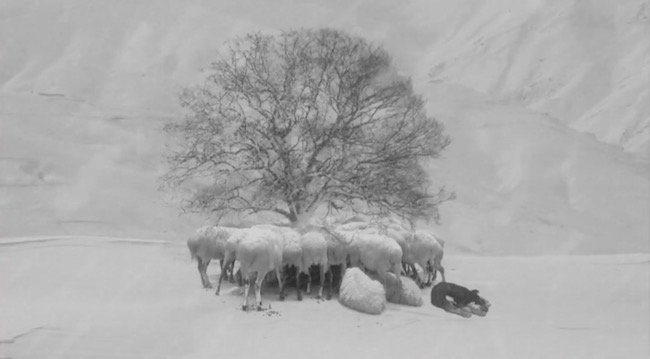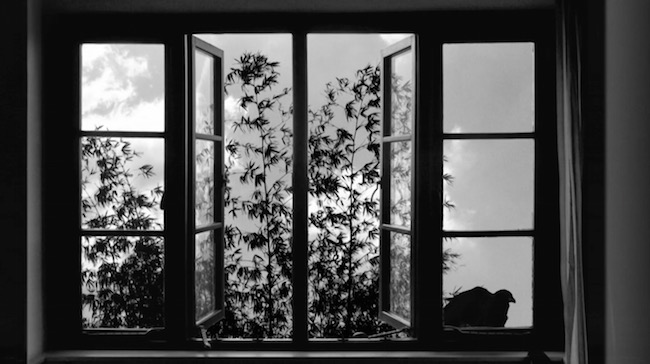Film Review: Abbas Kiarostami’s “24 Frames” — Final Photo Album
Iranian director Abbas Kiarostami’s last film is made up of a series of sometimes resplendent, sometimes disappointing, images.
24 Frames directed by Abbas Kiarostami. At the Museum of Fine Arts, Boston, through April 27.

An image from “24 Frames.”
By Neil Giordano
The late filmmaker Abbas Kiarostami was undoubtedly a humanist, but he was a determinedly enigmatic artist. His body of films serve up existential and aesthetic riddles packed into images filled with enormous beauty and passion. The title of his final movie (Kiarostami died in 2016, his son completed the work posthumously) suggests a multiplicity of meanings; its most direct significance is a reference to 24 of his own still photographs, transformed into short scenes inspired by the original frames. But the title also clearly hints at the elemental motion of cinema: film passes through the camera at 24 frames per second.
Yet, ironically, 24 Frames is not a “film” in the traditional sense. Instead, the director presents a series of digital photo-realistic animations in which he imagines the life that might be or might have been in the seconds and/or minutes that pass on either side of the split-second of a still photograph. Thus the film belies the traditional 24-frame-per-second structure. Perhaps we’re supposed to question whether cinema itself has transcended its original form?
The screen is always filled with beauty but, in terms of the latter question, many of the selected images do not provide the requisite transcendent frisson. The series opens with a somewhat aborted attempt at animating a Brueghel painting, introducing a motif of snow (or rain) and animals which continues on throughout many of the short scenes that follow. Horses, birds, and lions populate episodes of mostly undisturbed nature, seen from the perspective of a static observer. Not until over halfway through the series do we get our first sign of human beings, and that’s only for a second with a figure on a motorbike. (A reminder of man’s potential encroachment on otherwise serene landscapes?) Only two scenes in 24 Frames present people onscreen, one of them via a cheap optical illusion. Still, recurring themes of life and mortality permeate each sequence, so this isn’t a film celebrating nature so much as a meditation on the evanescence of life amid moments of serene reverie.

An image from “24 Frames.”
The sound design, as with any animation film, carries as much weight as the visuals. It is wonderfully effective here, if at times repetitive (oh, for some thunder!). Of course, sound is another add-on to a still photograph, so the film’s aural landscape of gulls and wind and waves crashing demands significant aesthetic attention. (This development is a bit of head-scratcher, given that sound design is not a major asset in Kiarostami’s previous films). The music and sound effects call attention to themselves in only a few of the scenes — most the time the diegetic soundscapes are not particularly intrusive.
From reports, Kiarostami never studied still photography in his lifetime, only picking up a camera after the 1979 revolution in Iran forced him to stop filmmaking for a few years. His philosophical vision in 24 Frames might well be a meditation on Susan Sontag’s contention that photography is as surreal as it is realistic. A picture captures the appearance of an object in a fraction of a second of time. Is Kiarostami questioning (by expanding) the limits of perception? Does a still photo hide as much reality as it reveals? Or is he just having fun with his art?
The last of the film’s 24 frames toys with a number of answers to these questions: its an emotional portrait of a young person, head down at a desk, with the finale of a classic Hollywood film presented on the adjacent computer screen (encased in what looks to be editing software). We watch the film run, frame by frame, to its closing credits, with Andrew Lloyd Webber’s tune “Love Never Dies” playing on the soundtrack. That set-up leads to 24 Frame‘s closing credits. Could the episode be the director’s final homage to the baffling, in terms of technique and aesthetic? Might it be a tender reminder of Kiarostami’s love affair with film? Or, as he’d probably have it, could it be both?
Neil Giordano teaches film and creative writing in Newton. His work as an editor, writer, and photographer has appeared in Harper’s, Newsday, Literal Mind, and other publications. Giordano previously was on the original editorial staff of DoubleTake magazine and taught at the Center for Documentary Studies at Duke University.
